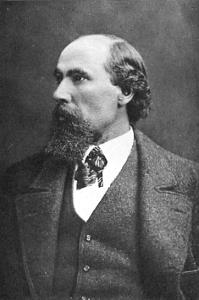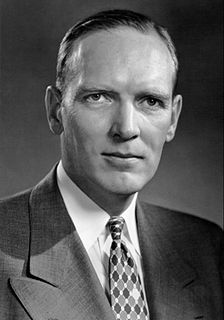
James Jerome Hill was a Canadian-American railroad executive. He was the chief executive officer of a family of lines headed by the Great Northern Railway, which served a substantial area of the Upper Midwest, the northern Great Plains, and Pacific Northwest. Because of the size of this region and the economic dominance exerted by the Hill lines, Hill became known during his lifetime as "The Empire Builder".

The Great Northern Railway was an American Class I railroad. Running from Saint Paul, Minnesota, to Seattle, Washington, it was the creation of 19th-century railroad entrepreneur James J. Hill and was developed from the Saint Paul & Pacific Railroad. The Great Northern's route was the northernmost transcontinental railroad route in the U.S.

The Burlington Northern Railroad was a United States-based railroad company formed from a merger of four major U.S. railroads. Burlington Northern operated between 1970 and 1996.

John Frank Stevens was an American civil engineer who built the Great Northern Railway in the United States and was chief engineer on the Panama Canal between 1905 and 1907.

The Northern Pacific Railway was a transcontinental railroad that operated across the northern tier of the western United States, from Minnesota to the Pacific Northwest. It was approved by Congress in 1864 and given nearly forty million acres of land grants, which it used to raise money in Europe for construction.

Robert Harris was a civil engineer and railroad executive who became president of the Chicago, Burlington and Quincy Railroad and Northern Pacific Railway.

John Marshall Budd was chairman and chief executive officer of Burlington Northern Railroad from 1970 to 1971, chairman from 1971 to 1972, and a director from 1970 to 1977.

John William Kendrick was chief engineer, general manager and vice-president of the Northern Pacific Railway and later vice-chairman of the board of the Atchison, Topeka and Santa Fe Railway.

General Adna Anderson was chief engineer of the Northern Pacific Railroad from 1880 to 1888. He first worked in railways in 1847, and worked his way up through various railways, leading to being an assistant engineer for the Army of the Potomac during the Civil War. Near the end of the war, he was placed in charge of all government railways. He returned to private industry in 1867, eventually leading to employment with Northern Pacific Railroad in 1881. There, he led construction of railways connecting St. Paul with both Portland and Seattle. He was vice president of the company from 1886 until leaving in 1888. After leaving Northern Pacific, he worked in an office in New York City for another year, where he shot himself on May 14, 1889. He died the next day.

Edward Jones Pearson was president of the New York, New Haven and Hartford Railroad.
Edwin Harrison McHenry was the fourth vice-president of the New York, New Haven and Hartford Railroad and first vice-president of the Consolidated Railway of Hartford, Connecticut. Prior to joining the New Haven, McHenry had been chief engineer and a receiver of the Northern Pacific Railway and later the chief engineer of the Canadian Pacific Railway.

The Minneapolis, St. Paul and Sault Ste. Marie Railroad (MStP&SSM) was a Class I railroad subsidiary of the Canadian Pacific Railway in the Midwestern United States. Commonly known since its opening in 1884 as the Soo Line after the phonetic spelling of Sault, it was merged with several other major CP subsidiaries on January 1, 1961 to form the Soo Line Railroad.
Elnathan Sweet was an American civil engineer and politician from New York. He was New York State Engineer and Surveyor from 1884 to 1887. He is credited with constructing the first cantilever arch bridge.

Charles Elliott Perkins was an American businessman and president of the Chicago, Burlington and Quincy Railroad. He was so well respected that historian Richard Overton wrote, "From the time that Charles Elliott Perkins became vice president of the Chicago, Burlington and Quincy [1876] ... until he resigned as president in 1901, he was the Burlington."
The Montana Central Railway was a railway company which operated in the American state of Montana from 1886 to 1907. It was constructed by James Jerome Hill's St. Paul, Minneapolis & Manitoba Railway, and became part of the Great Northern Railway in 1889.

The WPI Engineers football team represents Worcester Polytechnic Institute (WPI) in the sport of American football. The Engineers compete in Division III (DIII) of the National Collegiate Athletics Association (NCAA) and the NEWMAC. WPI's football program is one of the oldest in the country. The team has been coached by Chris Robertson since the 2010 season.
Howard G. Kelley was president of Grand Trunk Pacific Railway from 1917 to 1922.

David Allen Lucht is an American engineer and fire safety advocate. His career was devoted to public service in government, academia and the nonprofit sector. He served as the Ohio State Fire Marshal; the first presidential appointee to serve in the United States Fire Administration and the inaugural head of the graduate degree fire protection engineering program at Worcester Polytechnic Institute, where he served for 25 years

John Joseph Donovan was a Washington State pioneer and the president of the state Chamber of Commerce, as well as one of the key founders of the City Council of Bellingham, Washington. During his life, Donovan actively participated in political, industrial, and commercial activity on city, county, and state levels. Several historic landmarks exist in Bellingham honoring J. J. Donovan, including his house, which was added to the National Historic Register, and a bronze statue installed in Fairhaven, Washington.















